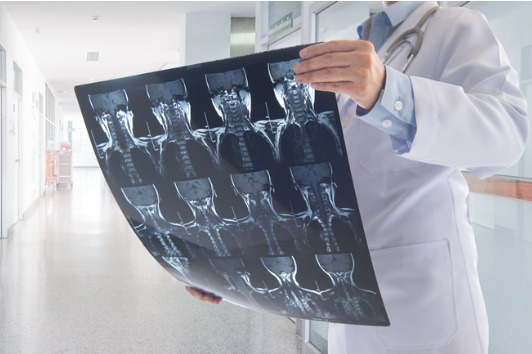Annular Disc Tear
UNDERSTANDING THE SYMPTOMS, CAUSES AND TREATMENTS
Understanding Annular Disc Tears
An intervertebral disc is the shock absorber of our spine. Each disc is located between two vertebral bodies. These discs are made of a strong outer ligamentous ring called the annulus fibrosus and an inner jelly-like section called the nucleus pulposus. The annulus fibrosus and nucleus pulposus work together to evenly distribute pressure across the disc. An annular disc tear is a tear in the outer ligamentous ring. This ligament is composed of strong fibers which are highly innervated with pain receptors so when a tear does occur it can cause significant symptoms.
As the discs act as shock absorbers between the vertebrae, whenever there is a high impact activity, trauma, or exertional/straining movements this added pressure wears on the disc. With increased pressure the discs will start to break down, lose hydration and flexibility contributing to cracks and tears. Tears in the outer ring of the disc, the annulus fibrosus, can cause mild to severe pain depending on where the tear is located. Although annular tears can occur throughout the spine they are more common in the neck and low back as these are more mobile than the thoracic spine. The pain results from tearing of the ligamentous fibers, leading to inflammation which may aggravate surrounding neural structures.
As an example, imagine an intervertebral disc as a jelly filled donut. There is a jelly center, outer bread lining. Imagine squeezing a jelly filled donut very slightly. The jelly will start to seep through the pores of the bread but not expel outside of the donut completely. This is similar to an annular tear as explained above, the integrity is disrupted but the contents of the disc are still held inside the annulus.
An intervertebral disc is the shock absorber of our spine. Each disc is located between two vertebral bodies. These discs are made of a strong outer ligamentous ring called the annulus fibrosus and an inner jelly-like section called the nucleus pulposus. The annulus fibrosus and nucleus pulposus work together to evenly distribute pressure across the disc. An annular disc tear is a tear in the outer ligamentous ring. This ligament is composed of strong fibers which are highly innervated with pain receptors so when a tear does occur it can cause significant symptoms.
As the discs act as shock absorbers between the vertebrae, whenever there is a high impact activity, trauma, or exertional/straining movements this added pressure wears on the disc. With increased pressure the discs will start to break down, lose hydration and flexibility contributing to cracks and tears. Tears in the outer ring of the disc, the annulus fibrosus, can cause mild to severe pain depending on where the tear is located. Although annular tears can occur throughout the spine they are more common in the neck and low back as these are more mobile than the thoracic spine. The pain results from tearing of the ligamentous fibers, leading to inflammation which may aggravate surrounding neural structures.
As an example, imagine an intervertebral disc as a jelly filled donut. There is a jelly center, outer bread lining. Imagine squeezing a jelly filled donut very slightly. The jelly will start to seep through the pores of the bread but not expel outside of the donut completely. This is similar to an annular tear as explained above, the integrity is disrupted but the contents of the disc are still held inside the annulus.


Symptoms
Most annular disc tears can cause pain ranging from mild to severe. The degree of pain often is directly related to the location and size of the tear.
Symptoms associated with an annular tear typically include:
- Pain and muscle spasm in the neck, mid or low back that can be described as sharp, dull, or aching.
- Radiating pain or spasm in the arms or legs
- Pain that increases with physical activity, sitting, or other positions that load pressure on the disc.
- Pain that increases with coughing, sneezing, bending forward, or lifting.
- Stiffness in muscles of the neck, mid back or low back.
- Tenderness around the area of pain
When to Seek Treatment
If you’re noticing symptoms associated with Annular Disc Tears and suspect a spinal issue, it’s crucial to consider consulting a board-certified spinal specialist. Reach out promptly to a certified spine surgeon for an accurate diagnosis and timely treatment. Early intervention can significantly improve your overall well-being and provide a broader range of treatment options, which may decrease as symptoms persist. The key to a successful and speedy recovery lies in addressing the root of the pain with your spine specialist as soon as symptoms arise.
While many people experience day-to-day back or neck pain, dismissing it as soreness, this may not be the case for everyone. If your pain persists for more than 10 days, it should be taken more seriously. Evaluate such prolonged pain with a spine surgeon to identify the root issue and determine the appropriate treatment. Additionally, be attentive to other signs related to back or neck pain that should not be ignored, including pain accompanied by fever, pain associated with loss of bladder control, and weakness/tingling/numbness in your arms or legs.
It’s important to note that these are general guidelines based on our expertise in spine care over the past three decades, recognizing that each patient’s symptoms may be unique.


Common Causes
Annular tears of the intervertebral disc can occur due to a many causes. Commonly they do occur as our discs naturally degenerate with age. When this occurs, the discs lose hydration and flexibility and therefore are at increased risk for tearing. Other factors contributing to annular tears include certain occupations or high impact activities putting intervertebral discs under added pressure.
Think of the disc as a rubber band, when new the rubber band stretches and then is able to return to normal. But with time, or more vigorous use or stretching it will start to crack and tear.
Here are a few examples of what can cause annular disc tears:
- Natural degeneration of the spine occurs with age
- When this occurs, the discs lose hydration and flexibility and therefore are at increased risk for tearing.
- Certain occupations or high impact activities cause added pressure to the intervertebral discs
- Repetitive lifting of heavy objects
- Running heavy machinery
- Consistent manual labor
- High impact trauma
- Car accidents
- Whiplash injury
- Falls
Diagnosing Annular Disc Tears
Patients undergo a thorough medical history and comprehensive exam to evaluate their pain and symptoms. In addition x-ray imaging is used to evaluate a patient’s spinal anatomy and look for any underlying abnormalities. The imaging study of choice to evaluate for an annular tear is magnetic resonance imaging (MRI). This study evaluates the soft tissue structures. However there are some situations where tears are not visible on an MRI which is why the history and physical is so vital.


Treatment Options
Most annular tears improve and heal over time with rest, spine-specialized physical therapy, and over the counter anti-inflammatories. In some situations symptoms may warrant prescription strength anti-inflammatories or possible pain or muscle relaxant medication.
Prevention
The best way to prevent an annular tear from happening is by maintaining a strong core to help stabilize your spine. A healthy well balanced diet is also important for your spinal health. When your spine is stable and healthy, there’s less pressure on the discs causing it to break down and tear.


